In acoustics, the design and sizing of plate resonators with circular, square or slotted perforations or not perforated (for silencers and absorbing linings) is a major issue.
Indeed, wisely used, resonators can make the lives of acoustics practitioners easier, if they have a reliable and user-friendly decision-making tool allowing them to solidly base, adjust (and personalize ?) the solutions they provide to problems relating to sound comfort improvement and to noise reduction (with a competitive advantage ?).
The acoustics calculation software SILDIS® allows the sizing of plate resonators with circular, square or slotted perforations, or even not perforated for the design of soundproofing devices e.g. silencers and absorbent linings.
Design and sizing of silencers for ventilation, air-conditioning networks or for industrial applications
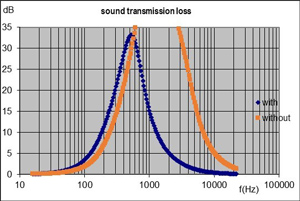
Fig. 1 Sound transmission loss of a resonant silencer with a 50 % open area ratio, with a length 1.2 m, consisting of splitters (baffles) with a thickness of 0.12 m made of a foam with a resistivity 10.5 kNsm-4, of porosity 0.95 with or without a perforated plate with slits 0.01 m wide (10 % perforation rate). For the frequency 250 Hz, the transmission loss reaches 16.0 dB (i.e. 12.8 dB/m) with the perforated protection, against 10.3 dB (i.e. 8.2 dB/m) without the perforated protection what allows (if the performance at 250 Hz is what one focuses on), to reduce by more than one third the length of the silencer..
It comes to the limitation of noise impact from aeraulic networks (standardized measurement according to standard NF EN ISO 7235 Acoustics - Laboratory measurement procedures for ducted silencers and air terminal units - Insertion loss, flow noise and total pressure loss).
The objective is often the improvement of the acoustic performance (in terms of transmission loss / insertion loss) at low frequency (e.g. in the octave band of central frequency 250 Hz), without the drawbacks that are sometimes associated with other modus operandi e.g. increase in length / thickness of splitters (baffles) or of peripheral absorbent lining with regard to compactness and cost, reduction in the open area ratio of a sound attenuator with regard to aerodynamic performance.
The implementation of a perforated sheet (e.g. steel or aluminum) with specific dimensional characteristics (purposefully selected) can then produce the desired effect without unfavorably affecting the pressure drop (this is not the only way to achieve - still without negative counterpart for aeraulics and also quantifiable with the softawre SILDIS® - such acoustic performance improvement for lowest frequencies, as discussed later in this article).
Figure 1 provides an example of simulation results in such a context with Module 1 of the software SILDIS® (in relation to the prediction of acoustic and aerodynamic performance of silencers).
Desing and sizing of absorbing linings for walls and roofs
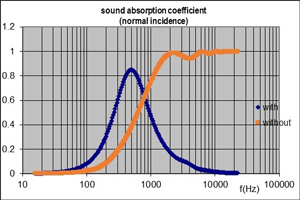
Fig. 2 Sound absorption coefficient (for normal incidence) of a resonator consisting of a thickness of 0.04 m of foam with a resistivity 10.5 kNsm-4, a porosity 0.95 with or without a perforated plate with slits 0.001 m wide (perforation rate 2 %). For the frequency 500 Hz, the sound absorption coefficient for normal incidence reaches 0.85 with the perforated protection, against 0.38 without the perforated protection.
It comes to the control of reverberation for the acoustic comfort of premises and/or for noise limitation (standard measurement according to NF EN ISO 354 Acoustics – Measurement of sound absorption in a reverberation room and also ISO 10534-1 Acoustics – Determination of sound absorption coefficient and impedance in impedance tubes – Part 1: Method using standing wave ratio).
The objective is often the optimization, at mid-high frequencies (e.g. in the octave band of central frequency 500 Hz), of the acoustic performance (in terms of sound absorption coefficient) of an absorber (itself poorly effective when placed - with a thin thickness - in front of a rigid impervious back (such as an ordinary partition) when a mechanical protection is required. Figure 2 provides an example of simulation results in such a context with Module 2 of the software SILDIS® (in relation to the prediction of acoustic performance of plane partitions).
Sizing of plate resonators with circular, square or slotted perforations or not perforated
The sizing of plate resonators with circular, square or slotted perforations with the software SILDIS® is namely based on the modeling of a multilayered acoustic structure, consisting of one (or more) such perforated plate(s) (e.g. metallic, made of wood, made of gypsum) [1] and porous media (e.g. wool - mineral or other -, foam) [2].




Fig. 3 Geometry of plates with (from left to right) circular (orthogonal or hexagonal arrangement), square or slotted perforations taken into account with the software SILDIS®
When this counts, the selection of perforated protections can take into account decorative aspects e.g. for the raw material nature and for the finish - depending on the archirectural deisgn -, provided that the properties influencing the sound absorption in the frequency band of interest are appropriate (this can be verified by a calculation with Module 2 of the software SILDIS®).
Figure 3 illustrates the geometry of perforated plates accounted with the software SILDIS®.
Simulations are also possible by considering one or more air gap(s), e.g. which can be contiguous with an absorber layer and/or envisaged between plates, wether perforated or not (e.g. to then constitute a damped plenum), as discussed later in this article.
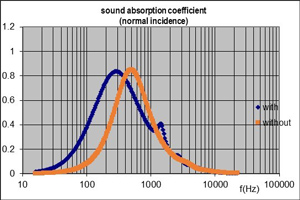
Fig. 4 Sound absorption coefficient (for normal incidence) of a resonator consisting of a thickness of 0.04 m of foam with a resistivity 10.5 kNsm-4, a porosity 0.95 with or without a perforated plate with slits 0.001 m wide (perforation rate 2 %). For the frequency 250 Hz, the sound absorption coefficient for normal incidence reaches 0.83 with a 0.08 m rear air-gap (plenum), against 0.46 without.
Figure 4 illustrates the consideration of an additional air-gap (plenum), at the rear of the 2-layer acoustic structure described above in relation to figure 2, with Module 2 of the SILDIS® software (in relation to the prediction of acoustic performance of plane partitions).
Generally, such a configuration is conducive to obtaining an increase in acoustic performance at low frequency, without additional cost as to the lining material, the quantity of which is unchanged ; a device (generally: involving frame profiles) allowing the rear spacing to be kept is, however, then required (what does not often pose a particular fixing problem: neither in the case of walls, nor in the case of a ceiling when it comes to a lining for the reverberation control of the room, but may require the implementation of an impervious rigid partition, in the central plane separating two half-slitters when it comes to a baffle silencer).
The calculation program also allows the consideration of a facing (e.g. cloth, fabric) [3] between the perforated plate and the porous medium (in somes cases: air, and nothing else) located behind the latter.
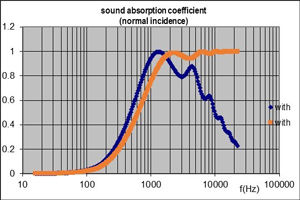
Fig. 5 Sound absorption coefficient (for normal incidence) of a 2-layer filling consisting of a thickness of 0.04 m of foam with a resistivity 10.5 kNsm-4, a porosity 0.95 with or without a cloth with an airflow resiastance 100 Nsm-3, with a porosity 0.05. For the frequency 6 kHz, the sound absorption coefficient for normal incidence reaches 0.67 with the cloth, against 1.00 without.
While in practical terms, the purpose of a cloth is often to prevent defibration (for fibrous lining materials) and / or to provide the necessary resistance to abrasion (a fortiori in the case of a grazing flow due to the high speed circulation of a fluid in a silencer), the consequence of its implementation (and therefore: often, its reson to be on an acoustic level, if nothing else presides over such a choice) is the contribution, for the surface impedance upstream of the considered multilayered structure, of a resistive term useful for obtaining acoustic performance when the only porous medium considered is air.
However, the application of a cloth upstream of a porous medium other than air can reduce the acoustic performance for high frequency, e.g. in the event of excessive resistance to airflow or of insufficient porosity: cf. figure 5 obtained with the module 2 of the sotware SILDIS® (in relation to the prediction of acoustic performance of plane partitions).
Sound propagation is taken into account in the different layers, namely with viscous effects requiring the consideration of appropriate end corrections for holes and slits (according to their geometry and size) of perforated plates (end, where applicable, for the perforations of some cloths), including interactions at the interface between layers (in relation to the effective density of equivalent fluids, and subsequent tortuosity changes).
The use of a plate resonator with circular, square or slotted perforations (for silencers and absorbent linings) often results in a (desired) very significant improvement in performance for low frequency, accompanied by a (sometimes: undesirable) reduction of performance for high frequencies, the latter can generally be compensated for by the complementary implementation of a soundproofing device based on a principle other than that of the Helmholtz resonator e.g. with a naked absorbing filling (e.g. made of polyester wool) or covered with a simple surfacing (cloth, fabric) with high porosity, and low airflow resistance (the performance of such a device can also be simulated with the software SILDIS®).
- silencers for ventilation, air-conditioning networks or for industrial applications : in the form of a dissipative stage installed in the same casing (then forming with the resonant sub-assembly a whole: sometimes referred to as hybrid silencer) or which can be a secondary silencer (dissociated)
- absorbent wall or ceiling linings: in the form of panels (and sometimes: suspended elements), generally more ordinary, easily available commercially, and covering other surfaces in room
Nonetheless, the use of a plate resonator with circular, square or slotted perforations (for silencers and absorbent linings) is not necessarily incompatible with acoustic performance for high(er) frequency, which can be namely obtained by suitable combination:
- dimensional characteristics of the perforated plate (depending on the geometry of the holes: diameter or side of punctual circular or square perforations, width of linear perforations i.e. slits), thickness and perforation ratio
- parameters influencing the sound propagation in the porous medium located behind the perforated plate (e.g. resistivity, porosity)
Design of multilayered acoustic structures
It should be noted that with the SILDIS® software, the following can be taken into account:
- from 1 to 4 sets (numbered from 1 to 4 in figure 6) of porous medium + cloth + perforated protection for multi-stage soundproofing devices

Fig. 6 Illustration of layer combinations possible with the software SILDIS® for calculations in relation to silencers and absorbing linings (some layers, with the exception of the « rear » layer, can – where required : easily - be ignored, depending on the acoustic structure to be simulated). « rear » : symetry plane / impervious rigid back or atmosphere (2 possibilities) - C, G, K, O : porous medium - D, H, L, P : cloth - E, I, M, Q : perforated protection
The possible layer combinations are numerous and varied ; each layer is fully configurable (except the « rear » layer when relating to an impervious rigid back: its surface impedance is then considered as being infinite), either using library elements of the software SILDIS® [4] or at user's initiative (BYO [5] concept).
The simulation possibilities are thus very extensive, whatever the multi-layered acoustic structure considered in the context of a soundproofing project, making it possible to cover all the known needs for usual applications (construction and industry).
For silencers and absorbent linings, the presence of wool (mineral or other), foam, cloth or fabric is not essential to obtain acoustic performance: the presence of air (and only air) on each side of the perforated protection may be sufficient (and then: savings are made), if the resistance induced by the viscous dissipation in relation to the perforations (then: desirably of characteristic dimension less than 1 mm and with a very low perforation rate ; it comes to microperforated plates) is satisfactory.
Figure 7 provides an example of simulation results in such a context with Module 2 of the software SILDIS®(in relation to the prediction of acoustic performance of plane partitions) ; figure 8 provides an example of simulation results in such a context with Module 1 of the software SILDIS® (in relation to the prediction of acoustic and aerodynamic performance of silencers).
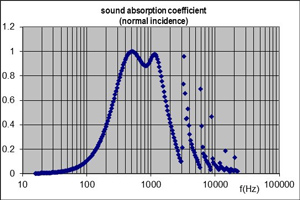
Fig. 7 Sound absorption coefficient (for normal incidence) of a double resonator consisting (from rear to front) of an air gap 0.05 m thick with a circular perforation plate with diameter 0.0003 m (perforation rate 1%), with an air gap 0.06 m thick with a circular perforation plate with a diameter of 0.0003 m (perforation rate 1.77%). For the frequency of 1k Hz, the sound absorption coefficient at normal incidence reaches 0.94.
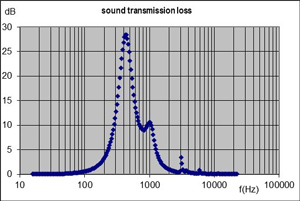
Fig. 8 Sound transmission loss of a resonator silencer with an open area ratio of 33.3%, with a length 1.2 m consisting of spiltters (baffles) constituted by the back-to-back installation (an infinitely rigid, waterproof partitioning could be required between them and transverse partions as well ?) of 2 layers as described in the key of figure 7. For the frequency of 1k Hz, the transmission loss reaches 10.6 dB (i.e. 8.8 dB/m).
As far as non-perforated sheets are concerned, they can be taken into account (then: assimilated to cloths with an infinite airflow resistance), possibly by considering their stiffness [6].
Figures 9 and 10 provide examples of simulation results in such a context with Module 2 of the software SILDIS® (in relation to the prediction of acoustic performance of plane partitions).
The use of such a device is possible for silencers; the consequence is then, in the manner of what is observed on the occasion of the implementation of a perforated plate, an increase - for special installation conditions - of the acoustic performance for low frequency: a given transmission loss (or a given insertion loss) can be obtained with a shorter length for the noise attenuator, without increasing the pressure drop.
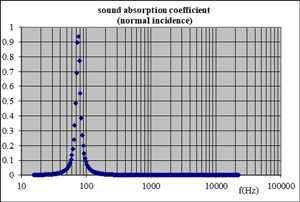
Fig. 9 Sound absorption coefficient (for normal incidence) of a resonator consisting of a thickness of 0.06 m of foam with a resistivity 10.5 kNsm-4, a porosity 0.95 covered with a non perforated plate mass density 7.8 kg/m2 without consideration of plate stiffness. For the frequency 76 Hz, the sound absorption coefficient for normal incidence reaches 0.94.
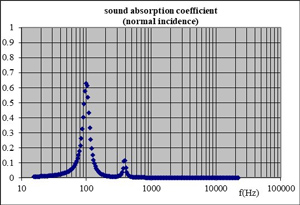
Fig. 10 Sound absorption coefficient (for normal incidence) of a resonator consisting of a thickness of 0.06 m of foam with a resistivity 10.5 kNsm-4, a porosity 0.95 covered with a non perforated plate mass density 7.8 kg/m2 with consideration of stiffness (palte made of steel, format 0.25 m times 0.25 m, simply supported). For the frequency 99 Hz, the sound absorption coefficient for normal incidence reaches 0.63.
Figures 11 and 12 provide examples of simulation results in such a context with Module 2 of the software SILDIS®. The use of such a device is possible for silencers ; the consequence is then, like what is observed for the implementation of a perforated plate, an increase - for particular installation condistions - in the acoustic performance at low frequency: a given transmission loss (or a given loss of insertion can be obtained with a shorter length of the noise attenuator, without increasing the pressure drop).
Applications in relation to design and sizing of plate resonators with circular, square or slotted perforations or not perforated
It would be difficult to provide an exhaustive list of all the simulations that can be performed with the software SILDIS® in this field, and of resulting applications, available features, in relation to architectural or industrial acoustics, being very extensive:
- silencers for ventilation, air-conditioning networks or for industrial applications : with ordinary splitters (e.g. filling made of mineral wool with cloth, of polyester wool, of foam) but also with splitters based on a quarter-wave resonator principle, with lateral or rear absorbing lining
- absorbent wall or ceiling linings: ordinary (e.g. with filling made of mineral wool with cloth or of polyester wool - including those for industrial soundproofing panels and noise barrier walls with perforated sheet -, of foam), but also multilayer absorber with membrane sandwiched between 2 thicknesses of porous material (possibly: with a seenable perforated sheet) for a wider sound absorption frequency range
It is possible, with modules 1 and 2 of the software SILDIS® (on the one hand, in relation to the prediction of acoustic and aerodynamic performance of silencers, and on the other hand, in relation to the prediction of acoustic performance of plane partitions), to carry out, without limitation - of any kind - of input data, and for any frequency band of interest betwen 20 Hz and 20 KHz, prediction calculations in the field of acoustics relating to a wide variety of soundproofing devices, e.g. plates with circular, square or slotted perforations or not perforated, associated to porous media, and, eventually, to cloths to obtain performance indicators (with output data in bands of 1/3 octave or 1/1 octave based on calculations performed for single frequencies) having to do with:
- sound absorption of a(n absorbent) lining: sound absorption coefficient for normal incidence, as illustrated by the previous examples, but also for statistical incidence and with an evaluation of the Sabine factor and of the absorption index αw
- noise reduction caused by a silencer: sound transmission loss as illustrated by the previous examples, but also insertion loss (taking into account reflection phenomena at silencer inlet and outlet, as well as by-pass phenomena), and considering self-noise i.e. flow noise (the total pressure loss is also calculated, for silencers with cross section being either rectangular or circular, with or without splitters)
The thermodynamic conditions (which vary the characteristics of the fluid - which can be air or another gas: O2, N2, steam, exhaust gas -) and therefore, where applicable, those of the absorbent filling and lining elements are taken into account for the simulations with the software SILDIS® (in particular: calculations are possible at Ultra High Temperature), what allow many applications in building sector as in industrial domain (cf. figures 11 and 12).
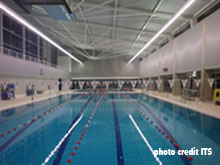
Fig. 11 Plate resonators with slits: photograph of an absorbing wall lining in a swimming pool (on the left and on the right of the shot, one can see in the foreground the horizontal slits which are visible only as vanishing lines in the background, although present there too). For this realization, a mineral wool was inserted at the rear: between the perforated plate - constituted by openwork blades - and the impervious rigid back - constituted by the masonry wall -.
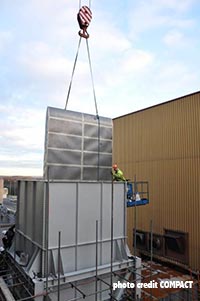
Fig. 12 Perforated protection (with circular holes): splitters of a combustion turbine exhaust silencer (during installation in a stack under construction)
What can be added in relation to calculations relating to plate resonators with circular, square or slotted perforations or not perforated with software SILDIS®
Calculations for design and sizing of plate resonators with circular, square or slotted perforations or not perforated with the sotware SILDIS® can be carried out in the context of acoustic engineering works or Research & Development tasks aiming at developing soundproofing components in the context of optimizing acoustic (and, if applicable: aeraulic performance) and limiting production costs.
The conditions for acquiring, learning and using the software (in Excel format) are in no way prohibitive with regard to episodic use, the availability of the tool (which can be used even by a non-hyper-specialized workforce) being - for the beneficiaries - total ; the calculation times are in no way prohibitive with regard to a use in a context requiring the quick obtaining of output data.
With regard to laboratory performance tests according to the standards which were mentioned above, the acoustic and (if applicable: aerodynamic) performance predictions with the software SILDIS® can sometimes (depending on the context):
- allow optimization of their preparation by limiting the number of tested configurations
- complete them by extending the domain of indicators evaluation (e.g. for other parameters combinations, for lower frequency or higher frequency)
- replace it for different reasons e.g. organizational, temporal or financial (then: sometimes providing flexibility in the choice of what the performance evaluation is about)
- allow to obtain what laboratory tests do not always allow to obtain e.g. high temperature performance evaluations, performance evaluations in terms of absorption coefficient without impervious rigid back (usually constituted by the rear of a Kundt's tube or the floor of a reverberation room) while such test conditions do not adequately account for the situation arising from the outdoor installation of a soundproofing panel ...)
With regard to other (often heavier) calculations means, predictions of acoustic and (if applicable: aerodynamic) performance with the software SILDIS® can sometimes (depending on the context):
- allow an optimization of their preparation by limiting the number of simulated configurations
- replace them for different reasons e.g. stewardship topics
- offer greater versatility, reliability and precision due to the robustness and sophistication of the models (sometimes: semi-empirical) implemented
The design and sizing of plate resonators with circular, square or slotted perforations or not perforated (for silencers and absorbent linings) with the software SILDIS® can be carried out either by the human resources of ITS (who developed and which markets this simulation tool: software publishing is an ITS activity assessed to meet the requirements of standard ISO 9001), or by self-service (with subscription) in ASP [7] mode.
[1] characteristics taken into account: porosity, geometry of the perforations, mass density, thickness
[2] characteristics taken into account: resistivity, porosity, tortuosity, thermal characteristic length, viscous characteristic length, density, thickness
[3] characteristics taken into account: resistance to air flow, mass density, thickness
[4] the specific characteristics of materials to be taken into account for the calculations - in addition to the thickness and number of layers, as well as their stacking order- are tabulated
[5] BYO = Bring Your Own (anglo-australian acronym)
[6] characteristics taken into account: Young's Modulus, density, Poisson's factor, loss coefficient, installation conditions (free or clamped), dimensions
[7] ASP = Application Service Provider from 250 €/month i.e. 277.50 US $/month ; the fixed price is that indicated in € (the price expressed in US $ is valid, as on December 5, 2019, when 1 € = 1.11 US $) ; VAT with a rate of 20% extra (if applicable, i.e. only for customers established in France) ; commissioning extra